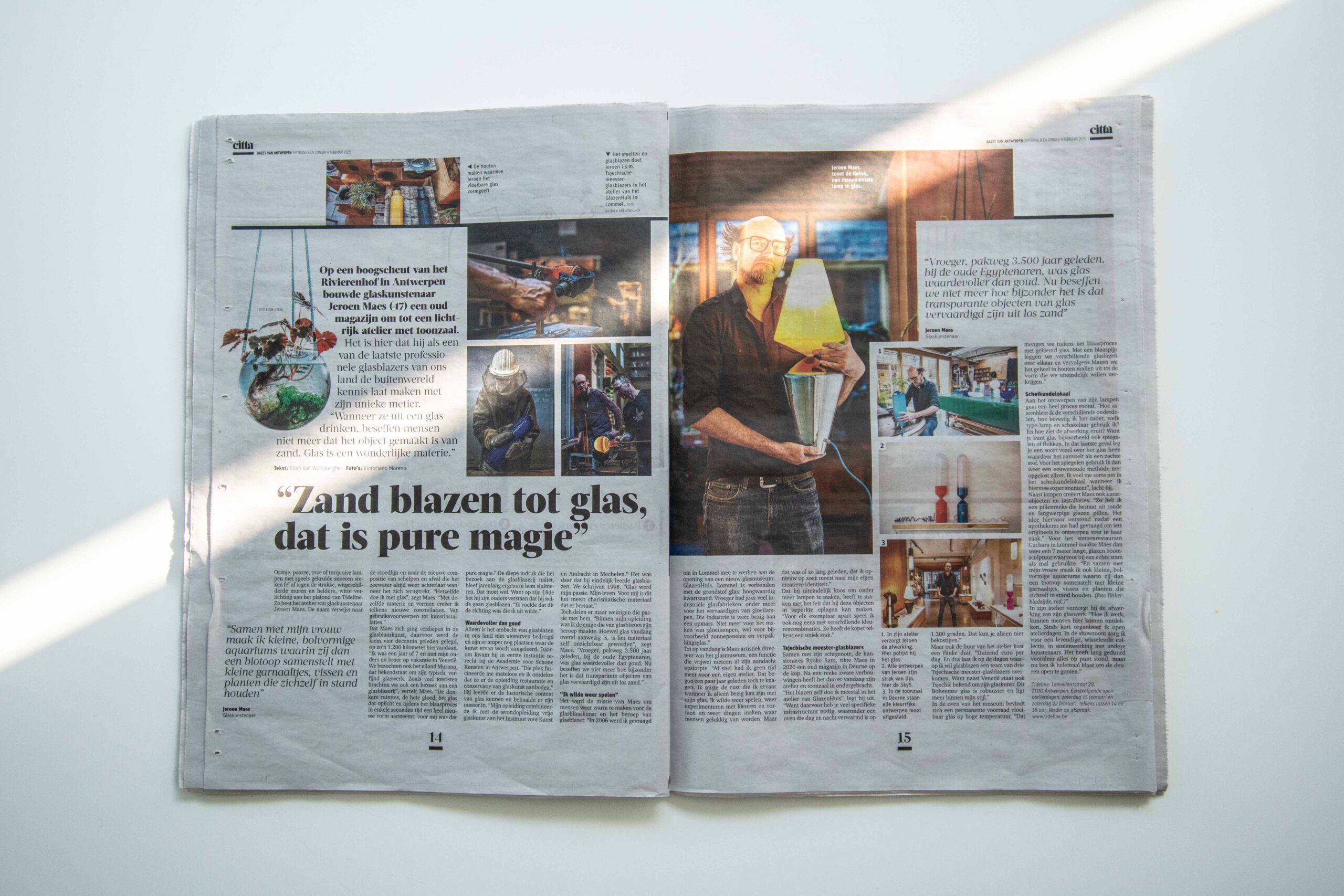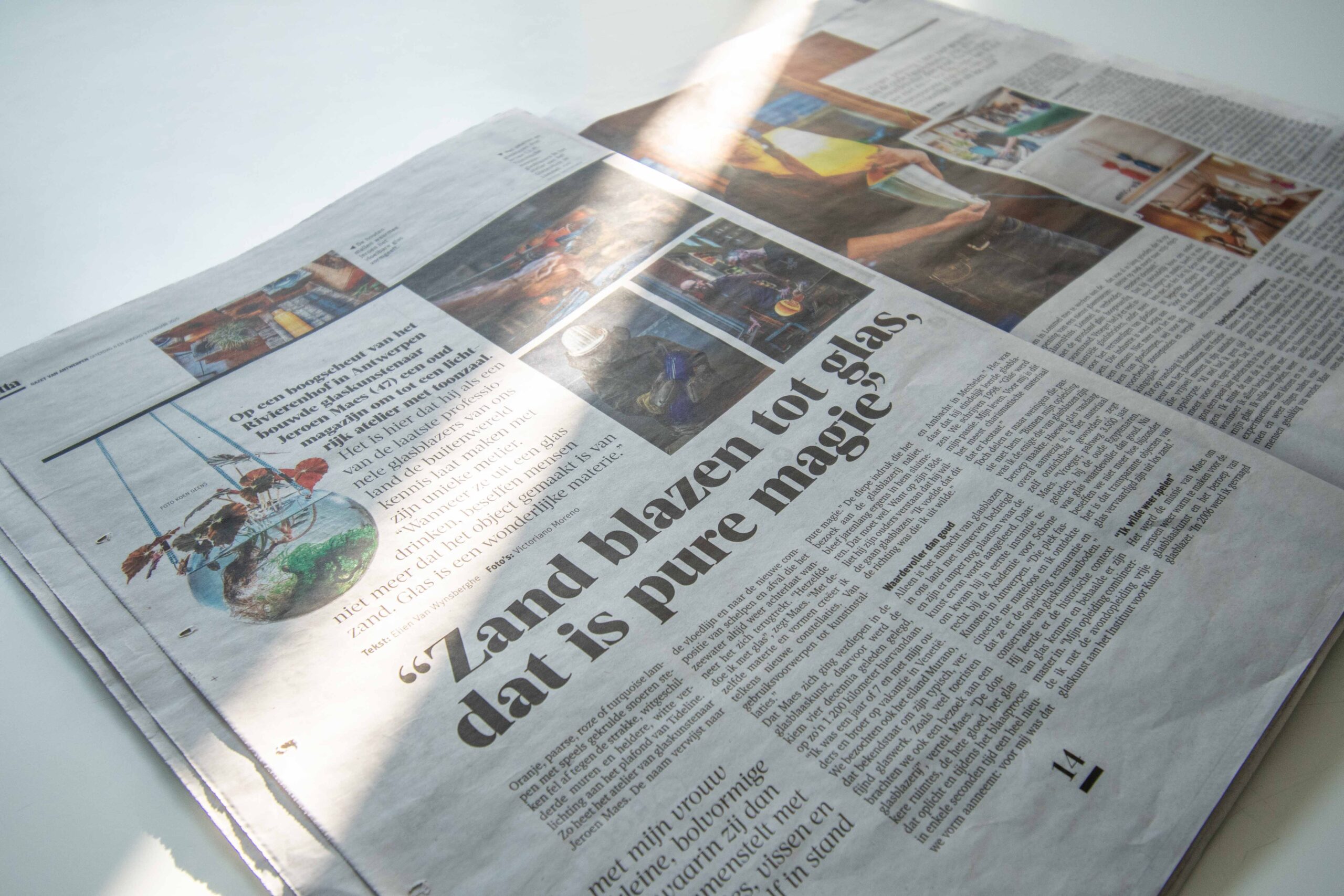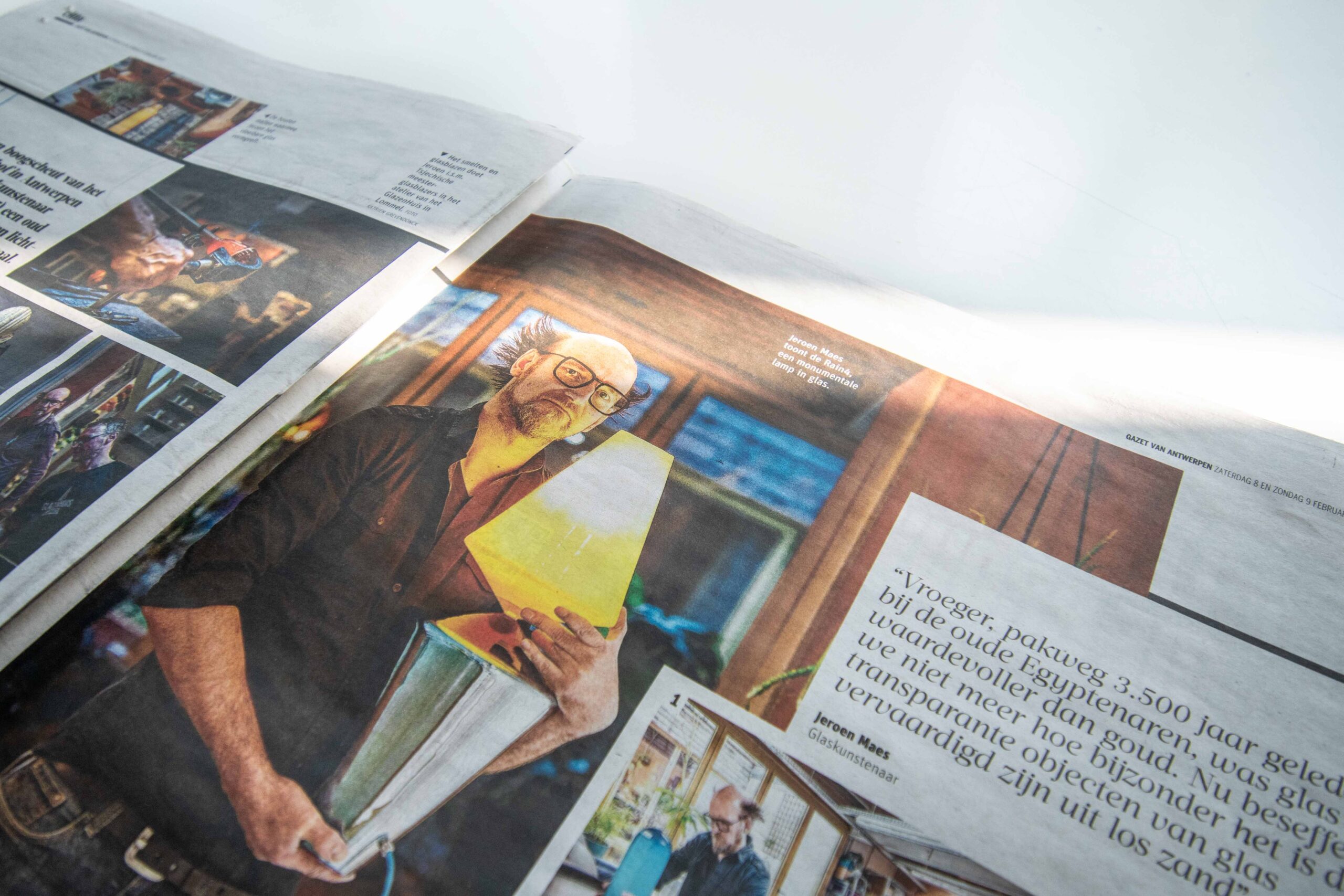Updates

Interview director GlazenHuis, Jeroen Maes
Interview in Gazet van Antwerpen
Jeroen Maes, director of GlazenHuis, appeared in an article in Gazet van Antwerpen in early February 2025. The article covered the following topics (summary):
Jeroen Maes is a passionate glass artist who showcases his unique talent and love for glassblowing from his personal studio, Tideline, in Antwerp. His fascination with glassblowing began at a young age during a visit to a glass workshop on the island of Murano in Venice. This passion led him to study at the Academy of Fine Arts in Antwerp, where he learned the art of glass restoration and conservation, and later at the Institute for Art and Craft in Mechelen, where he finally mastered glassblowing.
Maes considers glass to be a charismatic material and has made it his mission to raise awareness of the beauty and craftsmanship of glassblowing, an art form that is at risk of disappearing in Belgium.
In his studio, Maes not only designs lamps but also creates glass art objects and installations. The process of making his creations involves carefully assembling different components and applying various finishing techniques. Maes organizes open studio days for the public, sharing his passion for glassblowing and creating unique, limited-edition pieces to inspire a new generation of glass enthusiasts.
More information can be found at www.tideline.be.
Full Article
Just a stone’s throw from Rivierenhof Park in Antwerp, glass artist Jeroen Maes (47) transformed an old warehouse into a bright studio and showroom. As one of the last professional glassblowers in Belgium, he introduces the outside world to his unique craft. “When people drink from a glass, they rarely think about the fact that it is made from sand. Glass is a fascinating material.”
Vibrant orange, purple, pink, or turquoise lamps with playfully curled cords stand out against the crisp white walls and bright lighting of Tideline, the studio of glass artist Jeroen Maes. The name refers to the tide line—the ever-changing composition of shells and debris left behind by retreating seawater. “I do the same with glass,” says Maes. “With the same materials and forms, I constantly create new constellations, from functional objects to art installations.”
His journey into glassblowing began four decades ago, 1,200 kilometers from home. “I was about seven years old, on vacation in Venice with my parents and brother. We visited Murano, famous for its refined glasswork, and like many tourists, we stopped by a glassblowing workshop,” Maes recalls. “The dark spaces, the intense heat, the glowing glass transforming into a new shape in seconds—it was pure magic to me.” The visit left a lasting impression, and by the time he turned 18, he told his parents he wanted to pursue glassblowing. “I just knew this was the path I wanted to take.”
More Valuable Than Gold
However, glassblowing is a dying craft in Belgium, with very few places left to learn the art. This led Maes to study at the Academy of Fine Arts in Antwerp. “I was fascinated by the place and discovered they offered a program in glass restoration and conservation.” He gained in-depth knowledge of the historical context of glass and earned his master’s degree. “At the same time, I attended evening classes in glass art at the Institute for Art and Craft in Mechelen.” That’s where he finally learned the craft of glassblowing. This was in 1998. “Glass became my passion, my life. To me, it is the most charismatic material in existence.”
Few people share his passion, though. “I was the only one in my class who pursued glassblowing as a profession. Even though glass is everywhere today, the material itself has become invisible,” Maes explains. “In ancient Egypt, 3,500 years ago, glass was more valuable than gold. Today, we don’t even realize how extraordinary it is that transparent objects are made from loose sand.”
“I Wanted to Play Again.”
Maes made it his mission to rekindle interest in the art of glassblowing. “In 2006, I was invited to help establish a new glass museum in Lommel: GlazenHuis.” Lommel is closely linked to glassmaking, thanks to its high-quality quartz sand. The region once had many industrial glass factories, primarily producing light bulbs. Today, the industry is making a comeback—not for light bulbs, but for solar panels and packaging glass.
Maes remains the artistic director of GlazenHuis, a role that quickly consumed most of his time. “Before I knew it, I had no time left for my own studio. A few years ago, that started to weigh on me. I missed the peace of working with glass alone. I wanted to play again, to experiment with colors and shapes, to create pieces that make people happy. But it had been so long that I had to rediscover my creative identity.”
His decision to focus on lamps was partly because they could be produced in limited editions. “Each piece is unique because I experiment with different color combinations for every single lamp.”
Czech Master Glassblowers
Together with his wife, artist Ryoko Sato, Maes purchased an old warehouse in Deurne in 2020. After extensive renovations, the duo established their studio and showroom there. “I usually do the actual glassblowing at the GlazenHuis workshop,” he explains. “The process requires a highly specialized setup, including a furnace that must stay heated 24/7 at 1,300 degrees. That’s simply not affordable for an individual.”
Even renting the workshop comes at a high cost. “It’s 1,000 euros per day. So on the days I plan to blow glass, I bring in a team of three Czech master glassblowers. Alongside Venice, the Czech Republic is renowned for its glass artistry. Bohemian glass is sturdier and aligns more with my style.”
Inside the museum’s furnace, a permanent supply of molten glass is maintained at high temperatures. “During the glassblowing process, we mix it with colored glass. Using a blowpipe, we layer different types of glass and then blow the piece into wooden molds to achieve the final shape.”
A Chemistry Lab
Designing his lamps involves an intricate process. “How do I assemble the different components? How do I attach the cord? What type of bulb and switch should I use? And how should the finish look?” Glass can also be mirrored or flocked. “Flocking involves applying fibers to the glass, giving it a soft, fabric-like texture. For mirroring, I use an ancient method with dissolved silver. Sometimes, I feel like I’m in a chemistry lab while experimenting,” he laughs.
Besides lamps, Maes creates glass art and installations. “One of my series features glass pills—both round and elongated. The idea came after a pharmacist asked me to design something unique for her shop.”
For the Michelin-starred restaurant Cuchara in Lommel, he crafted a seven-meter-long glass tree sculpture, using an actual tree trunk as the mold. “Together with my wife, I also create small, spherical aquariums where she designs self-sustaining ecosystems with shrimp, fish, and plants.”
In his studio, he handles the final touches on his work. “Visitors can come and see my process. I recently started hosting open studio days. In my showroom, I maintain a dynamic, rotating collection in collaboration with other artists. It took a long time to get everything ready, but now I’m excited to open my doors.”
Source: Gazet van Antwerpen


